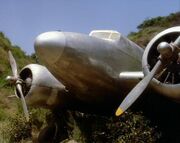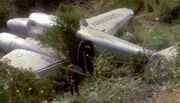m (robot Adding: nl) |
m (robot Adding: fr:Lockheed L-10 Electra) |
||
| (11 intermediate revisions by 7 users not shown) | |||
| Line 1: | Line 1: | ||
| − | [[ |
+ | [[File:Lockheed L-10 Electra (fore).jpg|thumb|Forward view]] |
| − | [[ |
+ | [[File:Lockheed L-10 Electra.jpg|thumb|Rear-quarter view]] |
The '''Lockheed L-10 Electra''' was a type of twin-engine [[airplane]] flown on [[Earth]] during the first half of the [[20th century]]. They were initially considered [[prototype|experimental]] aircraft, as they were the first to be constructed from metal, specifically an [[aluminum]] alloy. |
The '''Lockheed L-10 Electra''' was a type of twin-engine [[airplane]] flown on [[Earth]] during the first half of the [[20th century]]. They were initially considered [[prototype|experimental]] aircraft, as they were the first to be constructed from metal, specifically an [[aluminum]] alloy. |
||
| − | In [[1937]], [[Amelia Earhart]] and [[Fred Noonan]] flew a Lockheed L-10 Electra, [[registry number]] NR16020, during their attempt to circumnavigate the Earth. On July 2nd, they took off from [[New Guinea]] and headed east around the equator. During the flight, while running low on gas over the [[Pacific Ocean]], Earhart, Noonan and their plane were abducted by the [[Briori]] and taken to the [[Delta Quadrant]]. |
+ | In [[1937]], [[Amelia Earhart]] and [[Fred Noonan]] flew a Lockheed L-10 Electra, [[registry number]] NR16020, during their attempt to circumnavigate the Earth. On [[July|July 2nd]], they took off from [[New Guinea]] and headed east around the equator. During the flight, while running low on [[gasoline|gas]] over the [[Pacific Ocean]], Earhart, Noonan and their plane were abducted by the [[Briori]] and taken to the [[Delta Quadrant]]. |
| − | In [[2371]], the crew of the |
+ | In [[2371]], the crew of the {{USS|Voyager}} discovered the ancient Earth aircraft on the surface of a [[planet]], where the airplane was setup to send out an automated [[distress call]]. ({{VOY|The 37's}}) |
| − | + | {{bginfo|This aircraft was not identified by name on screen, but is derived from both corresponding historical accounts and visual identification from its appearance in "The 37's".}} |
|
| − | == |
+ | == External link == |
| − | * {{wikipedia |
+ | * {{wikipedia}} |
| − | [[Category:Earth]] |
+ | [[Category:Earth vehicles]] |
| + | |||
| + | [[de:Lockheed L-10 Electra]] |
||
| + | [[fr:Lockheed L-10 Electra]] |
||
[[nl:Lockheed L-10 Electra]] |
[[nl:Lockheed L-10 Electra]] |
||
Revision as of 17:43, 17 January 2011

Forward view

Rear-quarter view
The Lockheed L-10 Electra was a type of twin-engine airplane flown on Earth during the first half of the 20th century. They were initially considered experimental aircraft, as they were the first to be constructed from metal, specifically an aluminum alloy.
In 1937, Amelia Earhart and Fred Noonan flew a Lockheed L-10 Electra, registry number NR16020, during their attempt to circumnavigate the Earth. On July 2nd, they took off from New Guinea and headed east around the equator. During the flight, while running low on gas over the Pacific Ocean, Earhart, Noonan and their plane were abducted by the Briori and taken to the Delta Quadrant.
In 2371, the crew of the USS Voyager discovered the ancient Earth aircraft on the surface of a planet, where the airplane was setup to send out an automated distress call. (VOY: "The 37's")
